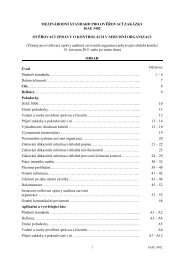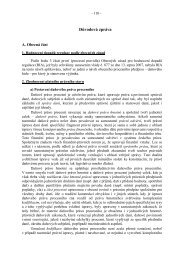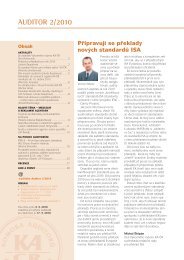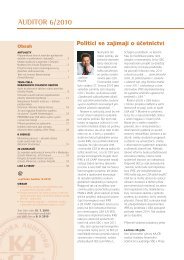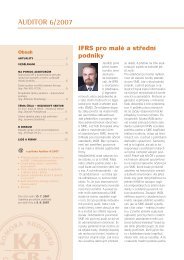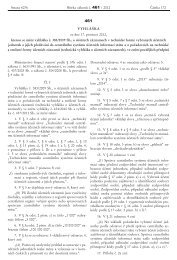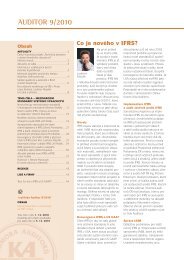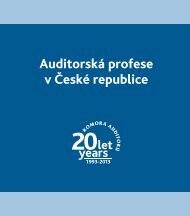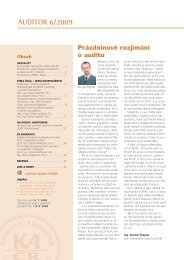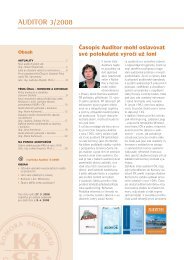Guide to Using International Standards on Auditing in - IFAC
Guide to Using International Standards on Auditing in - IFAC
Guide to Using International Standards on Auditing in - IFAC
You also want an ePaper? Increase the reach of your titles
YUMPU automatically turns print PDFs into web optimized ePapers that Google loves.
139<br />
<str<strong>on</strong>g>Guide</str<strong>on</strong>g> <str<strong>on</strong>g>to</str<strong>on</strong>g> <str<strong>on</strong>g>Us<strong>in</strong>g</str<strong>on</strong>g> <str<strong>on</strong>g>Internati<strong>on</strong>al</str<strong>on</strong>g> <str<strong>on</strong>g>Standards</str<strong>on</strong>g> <strong>on</strong> <strong>Audit<strong>in</strong>g</strong> <strong>in</strong> the Audits of Small- and Medium-Sized Entities Volume 1—Core C<strong>on</strong>cepts<br />
11.2 Risk Assessment<br />
Paragraph #<br />
Relevant Extracts from ISAs<br />
540.8 When perform<strong>in</strong>g risk assessment procedures and related activities <str<strong>on</strong>g>to</str<strong>on</strong>g> obta<strong>in</strong> an<br />
understand<strong>in</strong>g of the entity and its envir<strong>on</strong>ment, <strong>in</strong>clud<strong>in</strong>g the entity’s <strong>in</strong>ternal c<strong>on</strong>trol, as<br />
required by ISA 315, the audi<str<strong>on</strong>g>to</str<strong>on</strong>g>r shall obta<strong>in</strong> an understand<strong>in</strong>g of the follow<strong>in</strong>g <strong>in</strong> order <str<strong>on</strong>g>to</str<strong>on</strong>g><br />
provide a basis for the identificati<strong>on</strong> and assessment of the risks of material misstatement for<br />
account<strong>in</strong>g estimates: (Ref: Para. A12)<br />
(a) The requirements of the applicable f<strong>in</strong>ancial report<strong>in</strong>g framework relevant <str<strong>on</strong>g>to</str<strong>on</strong>g> account<strong>in</strong>g<br />
estimates, <strong>in</strong>clud<strong>in</strong>g related disclosures. (Ref: Para. A13-A15)<br />
(b) How management identifies those transacti<strong>on</strong>s, events and c<strong>on</strong>diti<strong>on</strong>s that may give<br />
rise <str<strong>on</strong>g>to</str<strong>on</strong>g> the need for account<strong>in</strong>g estimates <str<strong>on</strong>g>to</str<strong>on</strong>g> be recognized or disclosed <strong>in</strong> the f<strong>in</strong>ancial<br />
statements. In obta<strong>in</strong><strong>in</strong>g this understand<strong>in</strong>g, the audi<str<strong>on</strong>g>to</str<strong>on</strong>g>r shall make <strong>in</strong>quiries of<br />
management about changes <strong>in</strong> circumstances that may give rise <str<strong>on</strong>g>to</str<strong>on</strong>g> new, or the need <str<strong>on</strong>g>to</str<strong>on</strong>g><br />
revise exist<strong>in</strong>g, account<strong>in</strong>g estimates. (Ref: Para. A16-A21)<br />
(c) How management makes the account<strong>in</strong>g estimates, and an understand<strong>in</strong>g of the data <strong>on</strong><br />
which they are based, <strong>in</strong>clud<strong>in</strong>g: (Ref: Para. A22-A23)<br />
(i) The method, <strong>in</strong>clud<strong>in</strong>g where applicable the model, used <strong>in</strong> mak<strong>in</strong>g the account<strong>in</strong>g<br />
estimate; (Ref: Para. A24-A26)<br />
(ii) Relevant c<strong>on</strong>trols; (Ref: Para. A27-A28)<br />
(iii) Whether management has used a management expert; (Ref: Para. A29-A30)<br />
(iv) The assumpti<strong>on</strong>s underly<strong>in</strong>g the account<strong>in</strong>g estimates; (Ref: Para. A31-A36)<br />
(v) Whether there has been or ought <str<strong>on</strong>g>to</str<strong>on</strong>g> have been a change from the prior period <strong>in</strong> the<br />
methods for mak<strong>in</strong>g the account<strong>in</strong>g estimates, and if so, why; and (Ref: Para. A37)<br />
(vi) Whether and, if so, how management has assessed the effect of estimati<strong>on</strong><br />
uncerta<strong>in</strong>ty. (Ref: Para. A38)<br />
540.9 The audi<str<strong>on</strong>g>to</str<strong>on</strong>g>r shall review the outcome of account<strong>in</strong>g estimates <strong>in</strong>cluded <strong>in</strong> the prior period<br />
f<strong>in</strong>ancial statements, or, where applicable, their subsequent re-estimati<strong>on</strong> for the purpose of<br />
the current period. The nature and extent of the audi<str<strong>on</strong>g>to</str<strong>on</strong>g>r’s review takes account of the nature<br />
of the account<strong>in</strong>g estimates, and whether the <strong>in</strong>formati<strong>on</strong> obta<strong>in</strong>ed from the review would be<br />
relevant <str<strong>on</strong>g>to</str<strong>on</strong>g> identify<strong>in</strong>g and assess<strong>in</strong>g risks of material misstatement of account<strong>in</strong>g estimates<br />
made <strong>in</strong> the current period f<strong>in</strong>ancial statements. However, the review is not <strong>in</strong>tended <str<strong>on</strong>g>to</str<strong>on</strong>g><br />
call <strong>in</strong><str<strong>on</strong>g>to</str<strong>on</strong>g> questi<strong>on</strong> the judgments made <strong>in</strong> the prior periods that were based <strong>on</strong> <strong>in</strong>formati<strong>on</strong><br />
available at the time. (Ref: Para. A39-A44)<br />
540.10 In identify<strong>in</strong>g and assess<strong>in</strong>g the risks of material misstatement, as required by ISA 315, the<br />
audi<str<strong>on</strong>g>to</str<strong>on</strong>g>r shall evaluate the degree of estimati<strong>on</strong> uncerta<strong>in</strong>ty associated with an account<strong>in</strong>g<br />
estimate. (Ref: Para. A45-A46)<br />
540.11 The audi<str<strong>on</strong>g>to</str<strong>on</strong>g>r shall determ<strong>in</strong>e whether, <strong>in</strong> the audi<str<strong>on</strong>g>to</str<strong>on</strong>g>r’s judgment, any of those account<strong>in</strong>g<br />
estimates that have been identified as hav<strong>in</strong>g high estimati<strong>on</strong> uncerta<strong>in</strong>ty give rise <str<strong>on</strong>g>to</str<strong>on</strong>g><br />
significant risks. (Ref: Para. A47-A51)<br />
For smaller entities, the amount of work <strong>in</strong>volved <strong>in</strong> prepar<strong>in</strong>g estimates will be less complex, as their bus<strong>in</strong>ess<br />
activities are often limited and transacti<strong>on</strong>s are less complex. Often a s<strong>in</strong>gle pers<strong>on</strong>, such as the ownermanager,<br />
will identify the need for account<strong>in</strong>g estimates, and the audi<str<strong>on</strong>g>to</str<strong>on</strong>g>r may focus the <strong>in</strong>quiries accord<strong>in</strong>gly.<br />
However, smaller entities will also be less likely <str<strong>on</strong>g>to</str<strong>on</strong>g> have a management expert available who would use his<br />
or her experience and competence <str<strong>on</strong>g>to</str<strong>on</strong>g> make the required po<strong>in</strong>t estimates. In these cases, the risk of material<br />
misstatement might actually <strong>in</strong>crease, unless of course such an expert is hired.




